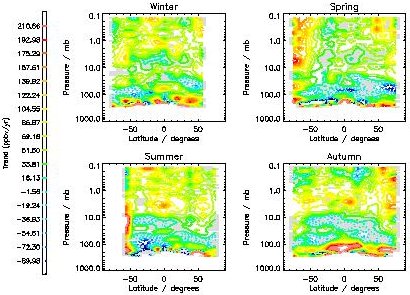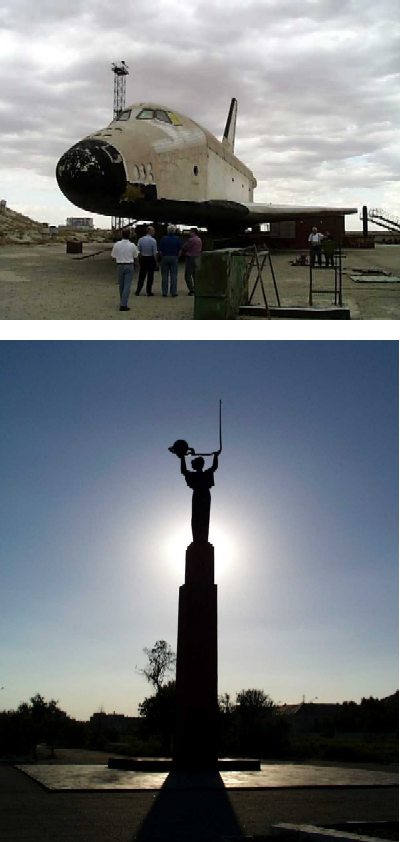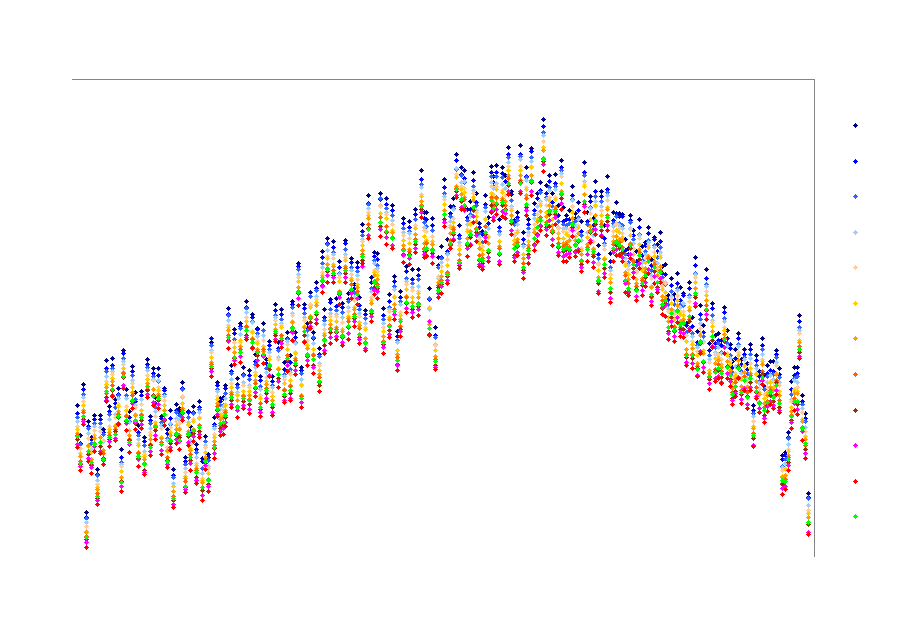
 |
|
News Page |

July 2000 |
This month's news stories:Stratospheric Water VapourVisit to Baikonur GERB-2 Calibration Complete |
 Stratospheric Water Vapour Work Highlighted in Geophysical Research Letters
Stratospheric Water Vapour Work Highlighted in Geophysical Research LettersA paper on stratospheric water vapour by SPAT PhD student, Claire Smith, was highlighted as a particularly important contribution to its field in the June 15th issue of Geophysical Research Letters (GRL). Typically only about one in six of papers in this highly regarded journal are featured in the highlights section at the front of each issue. Claire's paper, entitled Seasonal trends in stratospheric water vapour, and co-authored with Ralf Toumi and her supervisor, Jo Haigh, utilised water vapour data from the Halogen Occultation Experiment (HALOE) on the Upper Atmospheric Research Satellite (UARS) to investigate whether there were seasonal effects present in the data and their possible cause.
The most recent version of HALOE water vapour data was analysed using multiple linear regeression for long term trends. This analysis showed that over the period 1992-1999 stratospheric water vapour increased particularly above heights corresponding to a pressure of 10 hPa (or millibars). The data was further analysed on a seasonal basis to investigate if the rate of change of water vapour was significantly different for different times of the year. The figure on the right shows the derived seasonal trends - a larger, easier to read, version of the figure is available by clicking here or on the figure itself.
It has long been believed that the observed stratospheric increase in water vapour cannot all be accounted for by the oxidation of increased methane levels and therefore must be due to extra injection of water vapour from the troposphere. The very large increase visible in the tropical upper tropopshere in Autumn possibly suggests a source for the stratospheric increase. The winter trends appear to show a large increase in the region just above the tropical tropopause which may be related to the autumn increase. A possible mechanism for this autumn increase is that the second half of the Asian monsoon has intensified over recent years causing enhanced tropospheric-stratospheric exchange at this time of year.
The full paper can be read online in the electronic version of Geophysical Research Letters at GRL Online. This is the third paper this year with a SPAT student lead author to be highlighted in GRL - see the March 2000 SPAT News.
Bob Forsyth and Claire Smith 3rd July 2000
During June, Chris Carr, technical manager of SPAT's Cluster FGM team, visited Baikonur Cosmodrome in Kazakhstan, as part of the test programme of the Cluster II project. Here he reports back with his impressions from his visit to Russia's main launch site.

 Five times the size of France, Kazakhstan is the second largest of the Commonwealth of Independent States. Bordered by the Russian Federation to the north, the Caspian Sea, and China to the southeast, most of the country is made up of steppe, the sand massives of the Kara Kum and the vast desert of Kizilkum, while in the southeast of the country the mountains of the Tien Shan and the Altai form a great natural frontier with tens of thousands of lakes and rivers.
Five times the size of France, Kazakhstan is the second largest of the Commonwealth of Independent States. Bordered by the Russian Federation to the north, the Caspian Sea, and China to the southeast, most of the country is made up of steppe, the sand massives of the Kara Kum and the vast desert of Kizilkum, while in the southeast of the country the mountains of the Tien Shan and the Altai form a great natural frontier with tens of thousands of lakes and rivers.
To the East of the Aral Sea, in an area of otherwise un-inhabited desert, lies the Baikonur cosmodrome, from where the four Cluster spacecraft will be launched this summer. Construction of this secret missile site began in 1955. The first artificial satellite, Sputnik 1, and first human in space, Yuri Gagarin, were launched from Baikonur. All subsequent Russian manned missions have lifted off from there, as well as geostationary, lunar & planetary missions.
As a republic within the USSR, Kazakhstan suffered greatly from Stalinist purges and environmental damage, and saw the ethnic Russian portion of its population rise to nearly 40%. Current issues include the pace of market reform and privatization; fair and free elections, and how to convert the country's abundant energy resources into a better standard of living. The sensitive issue of Russian-Kazakh relations is centred on the cosmodrome, currently leased by Russia. Resident travel writer Chris Carr reports:
"Arriving into Baikonur by plane, one is struck by the huge expanses of flat sandy desert, broken only by patches of scrub vegetation and deep red scars of rock, exposed by the elements. In the distance, the tallest buildings of the cosmodrome dominate the horizon. The plane loses height quickly, and with a couple of turns we are lined up on the runway. This is the 20km of tarmac built for the Buran shuttle, which landed here after its one and only flight. Our landing is the smoothest I have ever experienced, and the pilot lets the plane run out for some distance, before executing a sharp u-turn and throttling up again. Before take off speed, he eases off ad we roll to the end of the airport. Two dogs run out and chase the plane until we come to rest near a green shed.
Travel within the CIS requires a change of pace; the adaptation occurs through the erosion of impatience. I learned to accept the things I cannot change, to run with the system rather than trying to beat it. This attitude pervades all aspects of officialdom, from posting a letter (one day of effort for a foreigner) through to customs clearance; it does not matter what one writes on the form, as long as it is completed in duplicate and stamped by the correct official.
Baikonur town is a shadow of its former self. Once formal parks and gardens are now patches of dirty sand. The population once peaked at some 130,000 at the height of the Buran/Energia programme, but is now down to just 30,000. Huge apartment blocks lie half empty. Nevertheless, the locals make every effort to hold back the desert and keep the town tidy.
Outside the recently-installed fences, one is in Kazakhstan. The cosmodrome, too large to fence-in, is a scattering of sites. Old facilities are left to decay, as is any unclaimed item. Building left-overs, old machinery and metalwork litter the desert. The authorities aim to attract western money, and to this end have re-painted some of the facilities. As a launch site, it's chief attraction is that it is so cheap, and (incredibly) reliable. To capitalize on this, they must adapt to a Western way of doing business, whilst retaining their success rate. I should care, or maybe I have already adapted to the system."
Chris Carr 7th July 2000

The GERB-2 flight instrument calibration, reported underway last month, was successfully completed on June 16th. More than 6 GBytes of data were collected during the 38 day period, during which measurements were made 24 hours per day, 7 days per week. All planned activities were completed and an initial look at the data for each has shown that the instrument is working very well. As an example the attached plot shows for each pixel how the gain of the instrument Total channel varies with telescope/detector temperature. Each coloured dot represents a different temperature (degC), one can see that the gain increases as the temperature drops. Closer inspection has shown that this is a linear relationship as also seen with the GERB-1 instrument.
![]() After a well-earned rest the calibration team will start the daunting task of reducing and analysing the collected data. Our webcam site Cali-Cam proved surprisingly popular during the calibration campaign. Take a look for a final message from the team.
After a well-earned rest the calibration team will start the daunting task of reducing and analysing the collected data. Our webcam site Cali-Cam proved surprisingly popular during the calibration campaign. Take a look for a final message from the team.
The third flight instrument, GERB-3, is expected to be arriving at IC for calibration towards the end of this year.
Steve Kellock 7th July 2000
View Last month's news, older news or return to Space and Atmospheric Physics home page